|
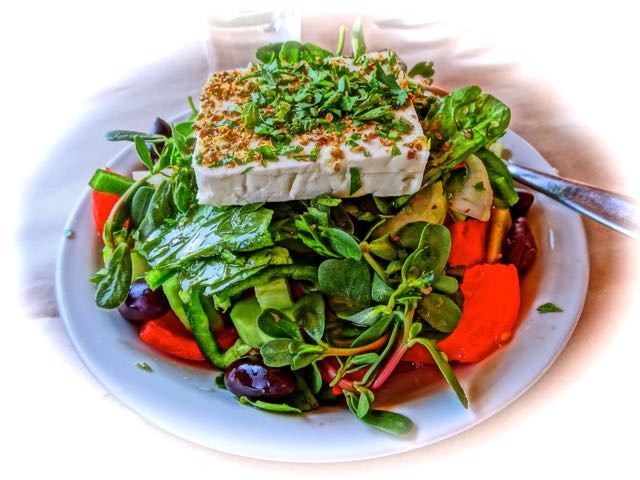 If you visit Greece in the summer and stay a couple weeks and are one of the lucky ones there are two things that will probably happen to you if you are able to break away from the tourist restaurants and find yourself in the places the locals eat. The first thing is that you will eat the best tomato you have ever tasted in you life,
probably as part of a horiatiki salata or what we in the English speaking world call a Greek Village Salad. Shortly thereafter you will eat the best melon you have ever eaten in your life. It may be a karpoozi (watermelon) or it may be a peponi (honey-dew melon) but you will
look at your wife or husband or child and say "I had no idea something could taste this good and not be bad for you." For some reason vegetables and fruits taste better in Greece than they do elsewhere. If you visit Greece in the summer and stay a couple weeks and are one of the lucky ones there are two things that will probably happen to you if you are able to break away from the tourist restaurants and find yourself in the places the locals eat. The first thing is that you will eat the best tomato you have ever tasted in you life,
probably as part of a horiatiki salata or what we in the English speaking world call a Greek Village Salad. Shortly thereafter you will eat the best melon you have ever eaten in your life. It may be a karpoozi (watermelon) or it may be a peponi (honey-dew melon) but you will
look at your wife or husband or child and say "I had no idea something could taste this good and not be bad for you." For some reason vegetables and fruits taste better in Greece than they do elsewhere.
|
|
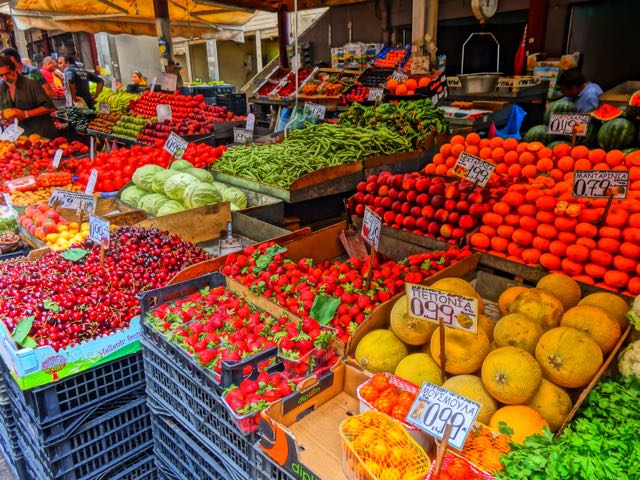 There are many theories of course. Some say it is the absence of pesticides. I have a theory of my own. Greece is made up of mountains and valleys. The farms are in the valleys. The water rains on the mountains and washes minerals into the
valleys. The more rich a fruit or vegetable is in minerals, the better it will taste. Of course I can't prove this and since many fruits and vegetables are now grown on large industrialized farms or even imported, without knowing what you are eating and where it comes from you have no way of knowing why it is good, or in some cases is not. Just because you may eat the best tomato or melon in your life during your stay in Greece does not mean that you will eat delicious vegetables rich in minerals at
every meal at every restaurant. But I can say with confidence that those restaurants where the Greeks eat, great care is taken in choosing the fruits and vegetables that are served that day. There are many theories of course. Some say it is the absence of pesticides. I have a theory of my own. Greece is made up of mountains and valleys. The farms are in the valleys. The water rains on the mountains and washes minerals into the
valleys. The more rich a fruit or vegetable is in minerals, the better it will taste. Of course I can't prove this and since many fruits and vegetables are now grown on large industrialized farms or even imported, without knowing what you are eating and where it comes from you have no way of knowing why it is good, or in some cases is not. Just because you may eat the best tomato or melon in your life during your stay in Greece does not mean that you will eat delicious vegetables rich in minerals at
every meal at every restaurant. But I can say with confidence that those restaurants where the Greeks eat, great care is taken in choosing the fruits and vegetables that are served that day.
|
|
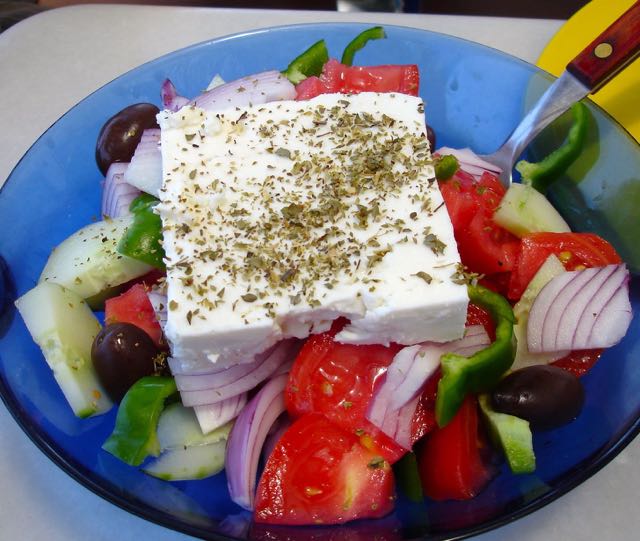 The Greeks eat seasonally. Take the previously mentioned horiatiki salata or the Greek Salad or Greek Village Salad as an example. Anyone going to Greece in the summer will find delicious horiaktiki salatas that consist of fresh ripe red tomatoes, green peppers, onions, cucumbers, olives, a big hunk
of feta cheese, extra virgin olive oil, oregano and if you are lucky maybe some capers! Not at every restaurant of course. You could go to some tourist joint that serves tomatoes that are closer to green than red, a smidgeon of crumbled feta and one olive, topped with whatever crappy oil they got a good deal on. But I am talking about a good honest Greek restaurant. If you eat a good horiatiki salata in season you will want to eat them for the rest of your life. In fact you will start a garden
so you can have
tomatoes
like the ones you ate in Greece. Another salad you may not be familiar with is the Cretan or dakos, which is like a horiatiki salata on top of a paximadi, which is a dried hard bread usually made from barley, though once the olive oil and juices soak in it is not hard for long. It is delicious and healthy too. Capers are found growing wild almost everywhere and their leaves and berries are pickled and added to salads. There is also a capari-salata which is made with capers,
olive oil, vinegar, garlic and onions and
is eaten on bread, like melitzana-salata. The Greeks eat seasonally. Take the previously mentioned horiatiki salata or the Greek Salad or Greek Village Salad as an example. Anyone going to Greece in the summer will find delicious horiaktiki salatas that consist of fresh ripe red tomatoes, green peppers, onions, cucumbers, olives, a big hunk
of feta cheese, extra virgin olive oil, oregano and if you are lucky maybe some capers! Not at every restaurant of course. You could go to some tourist joint that serves tomatoes that are closer to green than red, a smidgeon of crumbled feta and one olive, topped with whatever crappy oil they got a good deal on. But I am talking about a good honest Greek restaurant. If you eat a good horiatiki salata in season you will want to eat them for the rest of your life. In fact you will start a garden
so you can have
tomatoes
like the ones you ate in Greece. Another salad you may not be familiar with is the Cretan or dakos, which is like a horiatiki salata on top of a paximadi, which is a dried hard bread usually made from barley, though once the olive oil and juices soak in it is not hard for long. It is delicious and healthy too. Capers are found growing wild almost everywhere and their leaves and berries are pickled and added to salads. There is also a capari-salata which is made with capers,
olive oil, vinegar, garlic and onions and
is eaten on bread, like melitzana-salata.
|
|
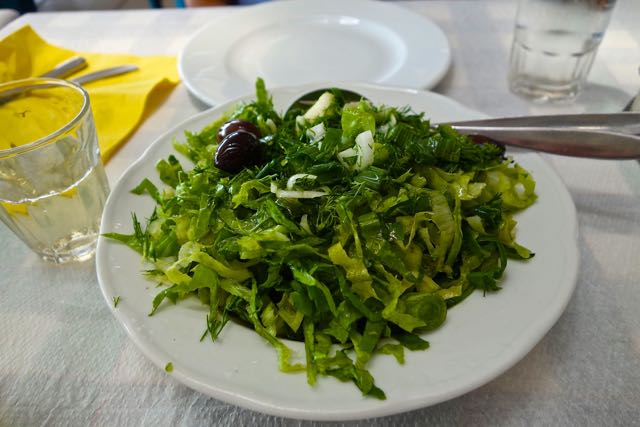 But what if you are not in Greece in the summer? What if it is late spring or fall or even winter and you order a horiatiki salata? If you are Greek or you know anything about Greece you probably don't. In the winter months (winter meaning any season that is not summer) you would eat a lachano-marouli salata (cabbage-lettuce
salad). Or a lachano-carota salata (cabbage-carrot salad). Or a plain marouli (lettuce) salata which often comes with dill and spring onions and is delicious. One of the keys to eating healthy is to eat fruits and vegetables in season. Sure you can find tomatoes grown somewhere during the winter, maybe even in Greece in hot houses in Crete or elsewhere. But they won't be as good tasting as what you will find in the summer and probably not as good for you. But trust me you will be
just as happy with a
green salad, and if you can find a politiki salata which is the spicy coleslaw type salad they eat in Thessaloniki you will forget all about horiatiki salatas until next summer. But what if you are not in Greece in the summer? What if it is late spring or fall or even winter and you order a horiatiki salata? If you are Greek or you know anything about Greece you probably don't. In the winter months (winter meaning any season that is not summer) you would eat a lachano-marouli salata (cabbage-lettuce
salad). Or a lachano-carota salata (cabbage-carrot salad). Or a plain marouli (lettuce) salata which often comes with dill and spring onions and is delicious. One of the keys to eating healthy is to eat fruits and vegetables in season. Sure you can find tomatoes grown somewhere during the winter, maybe even in Greece in hot houses in Crete or elsewhere. But they won't be as good tasting as what you will find in the summer and probably not as good for you. But trust me you will be
just as happy with a
green salad, and if you can find a politiki salata which is the spicy coleslaw type salad they eat in Thessaloniki you will forget all about horiatiki salatas until next summer.
|
|
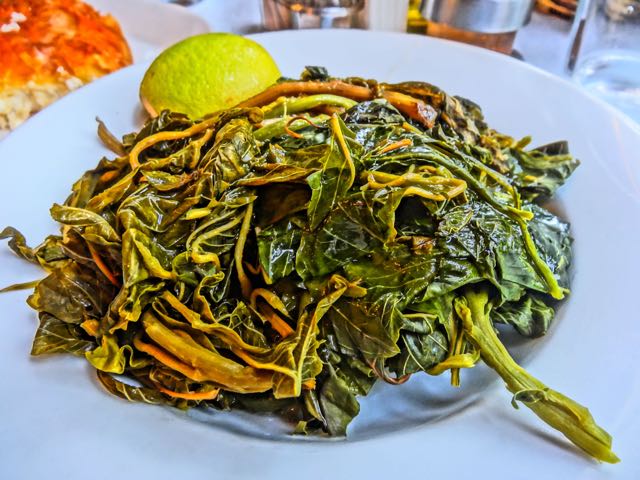 The healthiest thing you can eat in Greece are the hortas, or domesticated wild greens which if you come in the winter and spring you will see women picking by the side of the road. In the summer they eat vleeta which is wild amaranth and has been eaten since ancient times. In the winter they eat horta, which can be any one of a number
of wild greens.
Horta is usually a little bitter but is still delicious. Wild greens are boiled and then served with olive oil and lemon and are high in anti-oxidants as well as vitamins and minerals. For those who find they love the taste of these wild greens the seeds can be bought in packages at some of the garden shops on Evripidou street in Athens to take home with you. If you live near a large Mexican community you can probably find them in your local supermarket too. Horta and vleeta
are a major part of my diet in Greece. I probably eat them every meal and one thing I have noticed is that my toe
and finger nails are a lot harder to clip after a month in Greece. Another type of horta that is less common but also delicious is almira which grows along the coast. In Crete they have something called askrolimbi which is another type of horta but you eat mostly the stem and root rather than the greens. The healthiest thing you can eat in Greece are the hortas, or domesticated wild greens which if you come in the winter and spring you will see women picking by the side of the road. In the summer they eat vleeta which is wild amaranth and has been eaten since ancient times. In the winter they eat horta, which can be any one of a number
of wild greens.
Horta is usually a little bitter but is still delicious. Wild greens are boiled and then served with olive oil and lemon and are high in anti-oxidants as well as vitamins and minerals. For those who find they love the taste of these wild greens the seeds can be bought in packages at some of the garden shops on Evripidou street in Athens to take home with you. If you live near a large Mexican community you can probably find them in your local supermarket too. Horta and vleeta
are a major part of my diet in Greece. I probably eat them every meal and one thing I have noticed is that my toe
and finger nails are a lot harder to clip after a month in Greece. Another type of horta that is less common but also delicious is almira which grows along the coast. In Crete they have something called askrolimbi which is another type of horta but you eat mostly the stem and root rather than the greens.
|
|
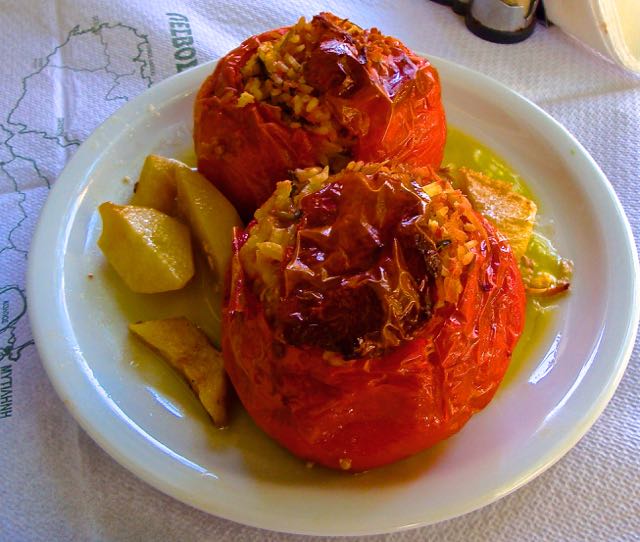 As I mentioned above, the Greeks have somehow perfected the tomato. I suppose people who spend time in Italy would say the same about their tomatoes too. The tomato, has only been a part of Greek cuisine since 1815, which is about the time it began to be used as a food in the United States (it was eaten by the native cultures in Central
and South America
and though introduced to North America in the 18th century, it was thought to be poisonous and was only used ornamentally.) One of the most important vegetables (or fruit if you want to get technical)
it is eaten raw (you can order a tomato salata which is just sliced tomato and olive oil), or used cooked in many dishes. The most well known is probably tomates gemista, which is stuffed, either with rice, onions and herbs or with rice and meat. For you vegetarians you need to ask the waiter if they are with meat or not. Tomatoes are used in a number of sauces for meat and vegetable dishes. On the island of Santorini where the tomatoes are small and compact in flavor, they are mixed with flour and egg,
deep-fried
and called tomato-keftedes. They are also delicious plain and there is an annual tomato convention on the island. As I mentioned above, the Greeks have somehow perfected the tomato. I suppose people who spend time in Italy would say the same about their tomatoes too. The tomato, has only been a part of Greek cuisine since 1815, which is about the time it began to be used as a food in the United States (it was eaten by the native cultures in Central
and South America
and though introduced to North America in the 18th century, it was thought to be poisonous and was only used ornamentally.) One of the most important vegetables (or fruit if you want to get technical)
it is eaten raw (you can order a tomato salata which is just sliced tomato and olive oil), or used cooked in many dishes. The most well known is probably tomates gemista, which is stuffed, either with rice, onions and herbs or with rice and meat. For you vegetarians you need to ask the waiter if they are with meat or not. Tomatoes are used in a number of sauces for meat and vegetable dishes. On the island of Santorini where the tomatoes are small and compact in flavor, they are mixed with flour and egg,
deep-fried
and called tomato-keftedes. They are also delicious plain and there is an annual tomato convention on the island.
|
|
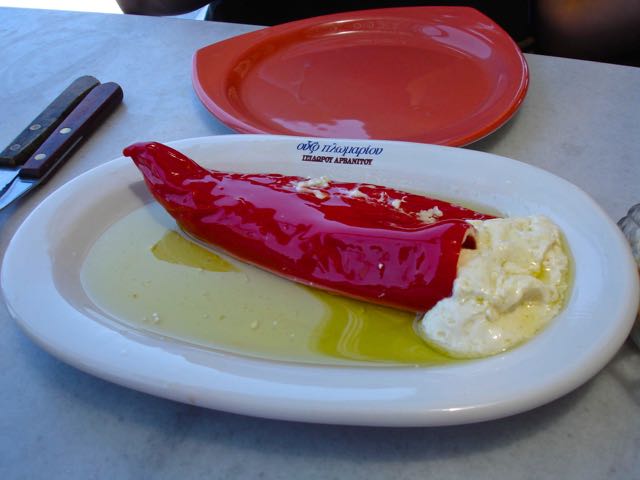 The most popular pepper is the green bell which like the tomato can be found in salads, stuffed with rice or meat, or grilled. In general the Greeks don't eat really spicy peppers though there are varieties of ground red pepper that are used for seasoning and there are the small green peppers that are pickled and found on
many a Greek salad in America.
My favorite peppers are the red ones from Florina in northern Greece, stuffed with cheese and baked, served as an appetizer with ouzo. In psistarias (grill houses) they often serve fried or grilled peppers which are seasoned with olive oil and vinegar. This award-winning pepper dish in the photo comes from a little hole-in-the-wall ouzerie on the island of Milos, called Medusa. The most common pepper dish is peperies gemista which is stuffed with rice and/or meat and served with
the stuffed tomatoes. The most popular pepper is the green bell which like the tomato can be found in salads, stuffed with rice or meat, or grilled. In general the Greeks don't eat really spicy peppers though there are varieties of ground red pepper that are used for seasoning and there are the small green peppers that are pickled and found on
many a Greek salad in America.
My favorite peppers are the red ones from Florina in northern Greece, stuffed with cheese and baked, served as an appetizer with ouzo. In psistarias (grill houses) they often serve fried or grilled peppers which are seasoned with olive oil and vinegar. This award-winning pepper dish in the photo comes from a little hole-in-the-wall ouzerie on the island of Milos, called Medusa. The most common pepper dish is peperies gemista which is stuffed with rice and/or meat and served with
the stuffed tomatoes.
|
|
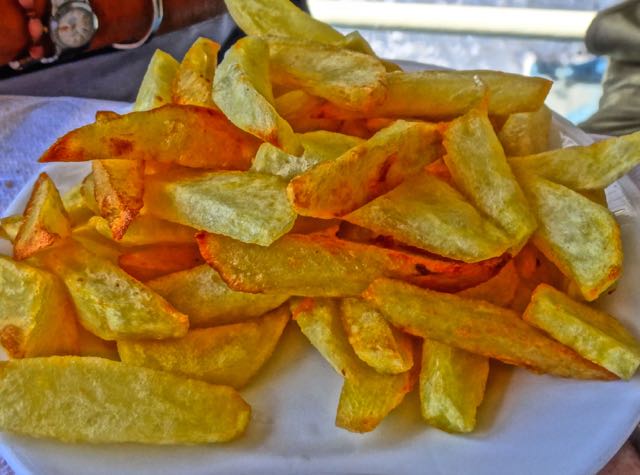 Potatoes are probably the most widely eaten vegetable in Greece and found in a number of stews. But for me there are two potato dishes that I dream about when I am far from Greece or my own kitchen. The first is patates sto fourno, the oven roasted potatoes that are served with lamb or chicken but can also be made by themselves.
Made with onions,
garlic, lemon, olive oil, salt, pepper and oregano this is what a potato was meant to taste like. The second is simply fried potatoes. No, not the greasy French fries from McDonalds or your local diner. I mean fresh cut potatoes, deep fried in olive-oil and topped with a squeeze of lemon and salt. When I was a starving hippy in the seventies I could live off fried potatoes and be quite happy about it. Even now I marvel at the taste and wonder how we in America could set our standards so low that we
would
be satisfied with the low quality fried potatoes that we poison ourselves and our children with. Another dish is patata salata which is like our potato salad except instead of mayo it is seasoned with parsley, onions, oil and lemon. Potatoes are probably the most widely eaten vegetable in Greece and found in a number of stews. But for me there are two potato dishes that I dream about when I am far from Greece or my own kitchen. The first is patates sto fourno, the oven roasted potatoes that are served with lamb or chicken but can also be made by themselves.
Made with onions,
garlic, lemon, olive oil, salt, pepper and oregano this is what a potato was meant to taste like. The second is simply fried potatoes. No, not the greasy French fries from McDonalds or your local diner. I mean fresh cut potatoes, deep fried in olive-oil and topped with a squeeze of lemon and salt. When I was a starving hippy in the seventies I could live off fried potatoes and be quite happy about it. Even now I marvel at the taste and wonder how we in America could set our standards so low that we
would
be satisfied with the low quality fried potatoes that we poison ourselves and our children with. Another dish is patata salata which is like our potato salad except instead of mayo it is seasoned with parsley, onions, oil and lemon.
|
|
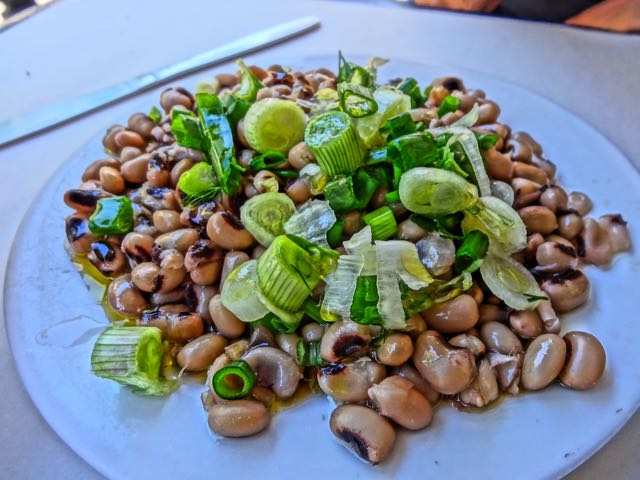 The Greeks eat a number of different beans. Gigandes are the big white broad beans that are cooked in tomato sauce. These can be found in almost every restaurant that serves food from the oven. Fasolakia are green string beans which can be cooked in tomato sauce, or are boiled and served like a salad with oil and lemon or vinegar.
Fasolada
is the famous bean soup that is practically the national dish of Greece, if it isn't the National Dish of Greece. Fakies are lentils and are found in lentil soup, after each individual lentil has been cleaned by hand by a little old lady. Fava is a dip or soup made from yellow split peas, not to be confused with one of the most interesting beans; koukia, which are these large brown beans, similar to foul moudamas which are a type of fava. These are eaten in the villages
and
they say that children should not eat them because they are poisonous to anyone under 16. Mavromatika is black-eyed-pea salad that is amazingly similar to what we eat on New Year's Day in North Carolina. The Greeks eat a number of different beans. Gigandes are the big white broad beans that are cooked in tomato sauce. These can be found in almost every restaurant that serves food from the oven. Fasolakia are green string beans which can be cooked in tomato sauce, or are boiled and served like a salad with oil and lemon or vinegar.
Fasolada
is the famous bean soup that is practically the national dish of Greece, if it isn't the National Dish of Greece. Fakies are lentils and are found in lentil soup, after each individual lentil has been cleaned by hand by a little old lady. Fava is a dip or soup made from yellow split peas, not to be confused with one of the most interesting beans; koukia, which are these large brown beans, similar to foul moudamas which are a type of fava. These are eaten in the villages
and
they say that children should not eat them because they are poisonous to anyone under 16. Mavromatika is black-eyed-pea salad that is amazingly similar to what we eat on New Year's Day in North Carolina.
|
|
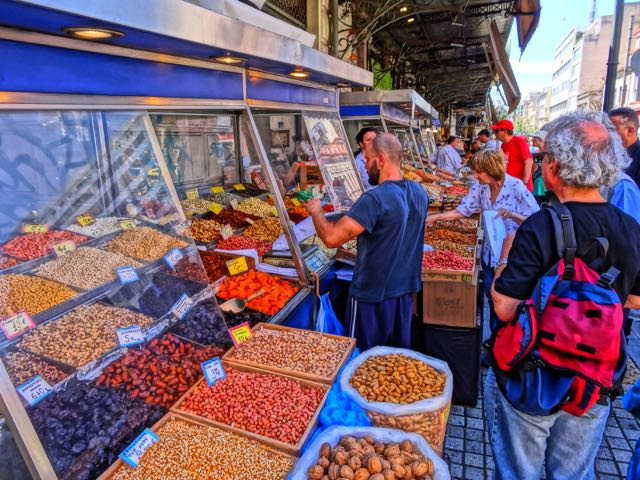 Revithia is the stew made from chick peas that is popular on the island of Sifnos, among other places and is flavored with rosemary. Chickpeas are also used to make revithia keftedes, fried chickpea balls which are similar to falafel though not eaten in a sandwich or pita but by themselves with lemon. Chickpeas
are also eaten dried, as a snack, as are various nuts, sunflower seeds and pasetempo, which are roasted and salted pumpkin seeds. My favorite are the red salted peanuts which can't be beat with a nice cold beer, and of course the pistachio nuts from the island of Aegina which are without a doubt the best in the world. Nuts are bought in shops that specialize in them and also by venders with carts that are found in areas where there is a lot of cafe life or on the main squares
in the islands and towns. Greek almonds are also especially good whether you eat them raw or roasted and salted. Revithia is the stew made from chick peas that is popular on the island of Sifnos, among other places and is flavored with rosemary. Chickpeas are also used to make revithia keftedes, fried chickpea balls which are similar to falafel though not eaten in a sandwich or pita but by themselves with lemon. Chickpeas
are also eaten dried, as a snack, as are various nuts, sunflower seeds and pasetempo, which are roasted and salted pumpkin seeds. My favorite are the red salted peanuts which can't be beat with a nice cold beer, and of course the pistachio nuts from the island of Aegina which are without a doubt the best in the world. Nuts are bought in shops that specialize in them and also by venders with carts that are found in areas where there is a lot of cafe life or on the main squares
in the islands and towns. Greek almonds are also especially good whether you eat them raw or roasted and salted.
|
|
 Without onions and garlic what would Greek food be? Onions are in almost every sauce and garlic is not used subtly in Greece. The best example being skordalia and sadziki (photo), two dips flavored so heavily with garlic that if you are with someone who is eating it, you might as well eat it too, even if you don't like the smell of
garlic, because
if you don't,
it is all you will smell for the next day or so. If you can't beat 'em join 'em. Onions and garlic are important in briam, a dish of vegetables baked in the oven, as well as the fourno patates I mentioned previously. Garlic is one of the healthiest foods available so if you don't like it you should. It will keep you well and deter any evil spirits that may be thinking of bothering you. Without onions and garlic what would Greek food be? Onions are in almost every sauce and garlic is not used subtly in Greece. The best example being skordalia and sadziki (photo), two dips flavored so heavily with garlic that if you are with someone who is eating it, you might as well eat it too, even if you don't like the smell of
garlic, because
if you don't,
it is all you will smell for the next day or so. If you can't beat 'em join 'em. Onions and garlic are important in briam, a dish of vegetables baked in the oven, as well as the fourno patates I mentioned previously. Garlic is one of the healthiest foods available so if you don't like it you should. It will keep you well and deter any evil spirits that may be thinking of bothering you.
|
|
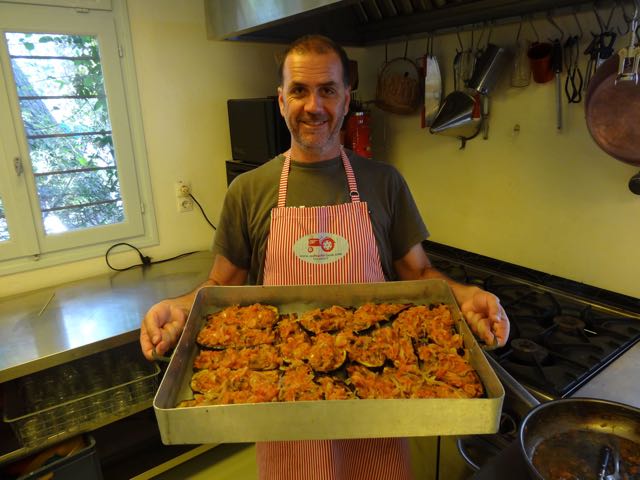 For a food that many thought was poison not too many centuries ago (like tomatoes) the Greek chefs make great use of eggplant. Papoutsakia are eggplant stuffed with onions, garlic, ground meat and herbs, topped with a béchamel sauce, but its cousin, emam is minus the meat and béchamel. Mousaka is also in the same
family
and though you can find vegetarian versions in hip restaurants like Eden in the Plaka it is pretty much a meat dish though in Aglaia Kremezi's FOODS OF GREECE she has a recipe for vegetarian mousaka as does Cindy Econopouly in her DIET OF THE GODS Greek entrée cookbook. Melitzana salata is a dip made from roasted eggplant, onions, garlic, peppers and can be found in most restaurants. There are usually two versions, one with mayo and one with oil and vinegar. Often the mayo version comes
in a
package from the nearest supermarket and put on the plate by the chef at the local tourist restaurant. Fried eggplant is called melitzanes tiganites and is served with sadziki (yogurt garlic sauce) and many tavernas and psistarias. If you don't like eggplant then get kolokithea tiganites which is the same thing but made with zucchini. For a food that many thought was poison not too many centuries ago (like tomatoes) the Greek chefs make great use of eggplant. Papoutsakia are eggplant stuffed with onions, garlic, ground meat and herbs, topped with a béchamel sauce, but its cousin, emam is minus the meat and béchamel. Mousaka is also in the same
family
and though you can find vegetarian versions in hip restaurants like Eden in the Plaka it is pretty much a meat dish though in Aglaia Kremezi's FOODS OF GREECE she has a recipe for vegetarian mousaka as does Cindy Econopouly in her DIET OF THE GODS Greek entrée cookbook. Melitzana salata is a dip made from roasted eggplant, onions, garlic, peppers and can be found in most restaurants. There are usually two versions, one with mayo and one with oil and vinegar. Often the mayo version comes
in a
package from the nearest supermarket and put on the plate by the chef at the local tourist restaurant. Fried eggplant is called melitzanes tiganites and is served with sadziki (yogurt garlic sauce) and many tavernas and psistarias. If you don't like eggplant then get kolokithea tiganites which is the same thing but made with zucchini.
|
|
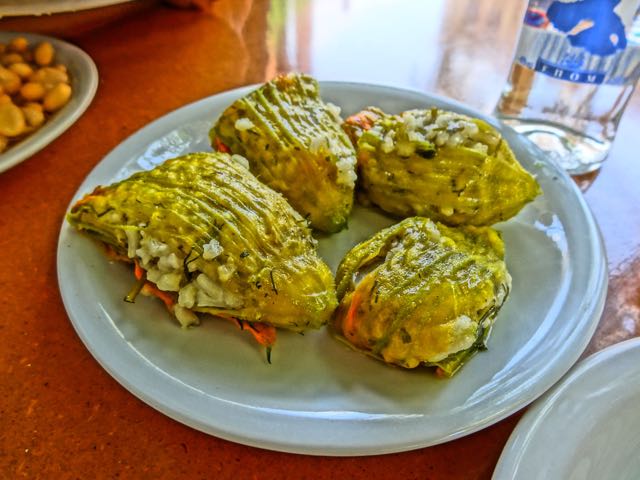 An interesting dish found in Lesvos are stuffed zucchini flowers, louloudakia, which can be deep-fried with cheese or boiled and stuffed with rice and herbs like dolmades (stuffed grape leaves). Kolokithia keftedes join the family of fried meatless balls and are probably the most popular
of all, made from grated
zucchini,
flour, onions and whatever secret recipe the chef knows. Stuffed zucchini or kolokithea gemista is another popular dish and like tomatoes and peppers you need to ask if it is with meat or without. Unlike the other gemista, kolokithea is usually served with avgolemono sauce, the egg lemon sauce which also flavors lamb fricasse and the egg-lemon soup that is to my family as chicken soup is to others when you have a cold or flu. Aginares (artichokes) are also served
in a stew of avgolemono sauce, with potatoes, carrots and onions. There are not many places where you could include the leaves of the grape as a vegetable but for lack of a better category I am writing about it here. Stuffed grape leaves, or dolmadas, are found in a couple of different styles, some with meat, some without, some with avgolemono sauce and some with olive oil, the latter often out of a can. An interesting dish found in Lesvos are stuffed zucchini flowers, louloudakia, which can be deep-fried with cheese or boiled and stuffed with rice and herbs like dolmades (stuffed grape leaves). Kolokithia keftedes join the family of fried meatless balls and are probably the most popular
of all, made from grated
zucchini,
flour, onions and whatever secret recipe the chef knows. Stuffed zucchini or kolokithea gemista is another popular dish and like tomatoes and peppers you need to ask if it is with meat or without. Unlike the other gemista, kolokithea is usually served with avgolemono sauce, the egg lemon sauce which also flavors lamb fricasse and the egg-lemon soup that is to my family as chicken soup is to others when you have a cold or flu. Aginares (artichokes) are also served
in a stew of avgolemono sauce, with potatoes, carrots and onions. There are not many places where you could include the leaves of the grape as a vegetable but for lack of a better category I am writing about it here. Stuffed grape leaves, or dolmadas, are found in a couple of different styles, some with meat, some without, some with avgolemono sauce and some with olive oil, the latter often out of a can.
|
|
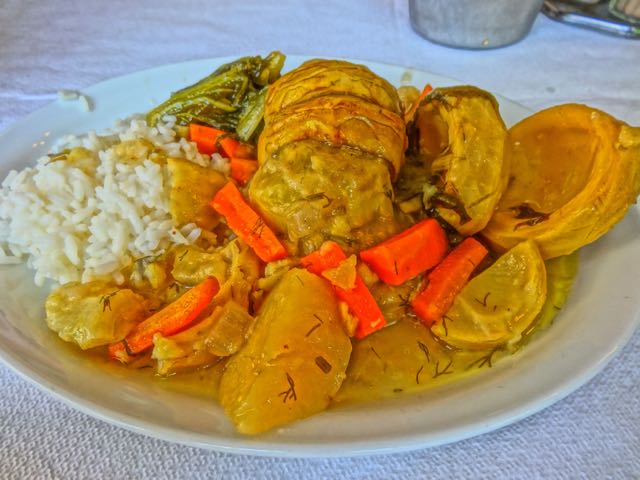 Other vegetables eaten in Greece are broccoli and cauliflower, usually boiled and seasoned with oil and vinegar or lemon, or avgolemono sauce. One of my favorite winter vegetable dishes is aginares which are fresh artichokes in avgolemono sauce(photo). Badzaria (beets) are boiled and served with skordalia
(garlic sauce). Street venders sell grilled corn-on-the-cob or roasted chestnuts. Vegetables are also put in various pies,
called pitas, but this is a whole other section. Prassos (leeks) are fairly common and are eaten in avgolemono sauce and in prasopita which is a leek pie, similar to spanakopita (spinach pie). Manitaria (mushrooms) are picked wild in the winter by those knowledgable enough to know the safe ones from the poisonous or otherwise. They can also be found in the markets which is a safer way to get them. One of my favorite weird food are the volvi which are
the bulbs
of the tasseled hyacinth and are served in the early spring. They supposedly have curative properties though my wife might argue that claim after sharing a plate and being stricken with a terrible case of diarrhea the next day on the flight back to America. They didn't bother me though. Other vegetables eaten in Greece are broccoli and cauliflower, usually boiled and seasoned with oil and vinegar or lemon, or avgolemono sauce. One of my favorite winter vegetable dishes is aginares which are fresh artichokes in avgolemono sauce(photo). Badzaria (beets) are boiled and served with skordalia
(garlic sauce). Street venders sell grilled corn-on-the-cob or roasted chestnuts. Vegetables are also put in various pies,
called pitas, but this is a whole other section. Prassos (leeks) are fairly common and are eaten in avgolemono sauce and in prasopita which is a leek pie, similar to spanakopita (spinach pie). Manitaria (mushrooms) are picked wild in the winter by those knowledgable enough to know the safe ones from the poisonous or otherwise. They can also be found in the markets which is a safer way to get them. One of my favorite weird food are the volvi which are
the bulbs
of the tasseled hyacinth and are served in the early spring. They supposedly have curative properties though my wife might argue that claim after sharing a plate and being stricken with a terrible case of diarrhea the next day on the flight back to America. They didn't bother me though.
|
|
 After dinner many restaurants will treat customers to sweets or a plate of fruit, usually seasonal. Karpoozi (water-melon), peponi (honeydew), or apples, pears, cherries, or oranges are popular. Figs ripen from mid-August through September and have to be tasted to be believed. While they seem to be getting
more popular in the USA and you can now buy
fresh figs at your local supermarket, there is still no comparison to the giant juicy figs you will find in Greece either at the market, or off some tree you walk by in the countryside where fig trees are almost like weeds. Oranges are a winter crop, grown in the Argolis, Crete and Rhodes. Bananas are imported but can be found on carts pushed by street venders or in the Athens Central market. Many fruits are made into preserves called glyka sto kotalirou (spoon sweets), incredibly sweet and only eaten
in small doses, like when you are a guest in someone's
house, served with a spoon and a cold glass of water. The Greeks have an amazing ability to turn some unlikely subjects into desserts, for example candied baby eggplants. What do they taste like? Well, they taste so sweet you would not know it was an eggplant and they prove that anything made with enough sugar becomes a dessert. But this is a subject for another section too. After dinner many restaurants will treat customers to sweets or a plate of fruit, usually seasonal. Karpoozi (water-melon), peponi (honeydew), or apples, pears, cherries, or oranges are popular. Figs ripen from mid-August through September and have to be tasted to be believed. While they seem to be getting
more popular in the USA and you can now buy
fresh figs at your local supermarket, there is still no comparison to the giant juicy figs you will find in Greece either at the market, or off some tree you walk by in the countryside where fig trees are almost like weeds. Oranges are a winter crop, grown in the Argolis, Crete and Rhodes. Bananas are imported but can be found on carts pushed by street venders or in the Athens Central market. Many fruits are made into preserves called glyka sto kotalirou (spoon sweets), incredibly sweet and only eaten
in small doses, like when you are a guest in someone's
house, served with a spoon and a cold glass of water. The Greeks have an amazing ability to turn some unlikely subjects into desserts, for example candied baby eggplants. What do they taste like? Well, they taste so sweet you would not know it was an eggplant and they prove that anything made with enough sugar becomes a dessert. But this is a subject for another section too.
|
|

 If you visit Greece in the summer and stay a couple weeks and are one of the lucky ones there are two things that will probably happen to you if you are able to break away from the tourist restaurants and find yourself in the places the locals eat. The first thing is that you will eat the best tomato you have ever tasted in you life,
probably as part of a horiatiki salata or what we in the English speaking world call a Greek Village Salad. Shortly thereafter you will eat the best melon you have ever eaten in your life. It may be a karpoozi (watermelon) or it may be a peponi (honey-dew melon) but you will
look at your wife or husband or child and say "I had no idea something could taste this good and not be bad for you." For some reason vegetables and fruits taste better in Greece than they do elsewhere.
If you visit Greece in the summer and stay a couple weeks and are one of the lucky ones there are two things that will probably happen to you if you are able to break away from the tourist restaurants and find yourself in the places the locals eat. The first thing is that you will eat the best tomato you have ever tasted in you life,
probably as part of a horiatiki salata or what we in the English speaking world call a Greek Village Salad. Shortly thereafter you will eat the best melon you have ever eaten in your life. It may be a karpoozi (watermelon) or it may be a peponi (honey-dew melon) but you will
look at your wife or husband or child and say "I had no idea something could taste this good and not be bad for you." For some reason vegetables and fruits taste better in Greece than they do elsewhere.  There are many theories of course. Some say it is the absence of pesticides. I have a theory of my own. Greece is made up of mountains and valleys. The farms are in the valleys. The water rains on the mountains and washes minerals into the
valleys. The more rich a fruit or vegetable is in minerals, the better it will taste. Of course I can't prove this and since many fruits and vegetables are now grown on large industrialized farms or even imported, without knowing what you are eating and where it comes from you have no way of knowing why it is good, or in some cases is not. Just because you may eat the best tomato or melon in your life during your stay in Greece does not mean that you will eat delicious vegetables rich in minerals at
every meal at every restaurant. But I can say with confidence that those restaurants where the Greeks eat, great care is taken in choosing the fruits and vegetables that are served that day.
There are many theories of course. Some say it is the absence of pesticides. I have a theory of my own. Greece is made up of mountains and valleys. The farms are in the valleys. The water rains on the mountains and washes minerals into the
valleys. The more rich a fruit or vegetable is in minerals, the better it will taste. Of course I can't prove this and since many fruits and vegetables are now grown on large industrialized farms or even imported, without knowing what you are eating and where it comes from you have no way of knowing why it is good, or in some cases is not. Just because you may eat the best tomato or melon in your life during your stay in Greece does not mean that you will eat delicious vegetables rich in minerals at
every meal at every restaurant. But I can say with confidence that those restaurants where the Greeks eat, great care is taken in choosing the fruits and vegetables that are served that day. The Greeks eat seasonally. Take the previously mentioned horiatiki salata or the Greek Salad or Greek Village Salad as an example. Anyone going to Greece in the summer will find delicious horiaktiki salatas that consist of fresh ripe red tomatoes, green peppers, onions, cucumbers, olives, a big hunk
of feta cheese, extra virgin olive oil, oregano and if you are lucky maybe some capers! Not at every restaurant of course. You could go to some tourist joint that serves tomatoes that are closer to green than red, a smidgeon of crumbled feta and one olive, topped with whatever crappy oil they got a good deal on. But I am talking about a good honest Greek restaurant. If you eat a good horiatiki salata in season you will want to eat them for the rest of your life. In fact you will start a garden
so you can have
tomatoes
like the ones you ate in Greece. Another salad you may not be familiar with is the Cretan or dakos, which is like a horiatiki salata on top of a paximadi, which is a dried hard bread usually made from barley, though once the olive oil and juices soak in it is not hard for long. It is delicious and healthy too. Capers are found growing wild almost everywhere and their leaves and berries are pickled and added to salads. There is also a capari-salata which is made with capers,
olive oil, vinegar, garlic and onions and
is eaten on bread, like melitzana-salata.
The Greeks eat seasonally. Take the previously mentioned horiatiki salata or the Greek Salad or Greek Village Salad as an example. Anyone going to Greece in the summer will find delicious horiaktiki salatas that consist of fresh ripe red tomatoes, green peppers, onions, cucumbers, olives, a big hunk
of feta cheese, extra virgin olive oil, oregano and if you are lucky maybe some capers! Not at every restaurant of course. You could go to some tourist joint that serves tomatoes that are closer to green than red, a smidgeon of crumbled feta and one olive, topped with whatever crappy oil they got a good deal on. But I am talking about a good honest Greek restaurant. If you eat a good horiatiki salata in season you will want to eat them for the rest of your life. In fact you will start a garden
so you can have
tomatoes
like the ones you ate in Greece. Another salad you may not be familiar with is the Cretan or dakos, which is like a horiatiki salata on top of a paximadi, which is a dried hard bread usually made from barley, though once the olive oil and juices soak in it is not hard for long. It is delicious and healthy too. Capers are found growing wild almost everywhere and their leaves and berries are pickled and added to salads. There is also a capari-salata which is made with capers,
olive oil, vinegar, garlic and onions and
is eaten on bread, like melitzana-salata. But what if you are not in Greece in the summer? What if it is late spring or fall or even winter and you order a horiatiki salata? If you are Greek or you know anything about Greece you probably don't. In the winter months (winter meaning any season that is not summer) you would eat a lachano-marouli salata (cabbage-lettuce
salad). Or a lachano-carota salata (cabbage-carrot salad). Or a plain marouli (lettuce) salata which often comes with dill and spring onions and is delicious. One of the keys to eating healthy is to eat fruits and vegetables in season. Sure you can find tomatoes grown somewhere during the winter, maybe even in Greece in hot houses in Crete or elsewhere. But they won't be as good tasting as what you will find in the summer and probably not as good for you. But trust me you will be
just as happy with a
green salad, and if you can find a politiki salata which is the spicy coleslaw type salad they eat in Thessaloniki you will forget all about horiatiki salatas until next summer.
But what if you are not in Greece in the summer? What if it is late spring or fall or even winter and you order a horiatiki salata? If you are Greek or you know anything about Greece you probably don't. In the winter months (winter meaning any season that is not summer) you would eat a lachano-marouli salata (cabbage-lettuce
salad). Or a lachano-carota salata (cabbage-carrot salad). Or a plain marouli (lettuce) salata which often comes with dill and spring onions and is delicious. One of the keys to eating healthy is to eat fruits and vegetables in season. Sure you can find tomatoes grown somewhere during the winter, maybe even in Greece in hot houses in Crete or elsewhere. But they won't be as good tasting as what you will find in the summer and probably not as good for you. But trust me you will be
just as happy with a
green salad, and if you can find a politiki salata which is the spicy coleslaw type salad they eat in Thessaloniki you will forget all about horiatiki salatas until next summer.  The healthiest thing you can eat in Greece are the hortas, or domesticated wild greens which if you come in the winter and spring you will see women picking by the side of the road. In the summer they eat vleeta which is wild amaranth and has been eaten since ancient times. In the winter they eat horta, which can be any one of a number
of wild greens.
Horta is usually a little bitter but is still delicious. Wild greens are boiled and then served with olive oil and lemon and are high in anti-oxidants as well as vitamins and minerals. For those who find they love the taste of these wild greens the seeds can be bought in packages at some of the garden shops on Evripidou street in Athens to take home with you. If you live near a large Mexican community you can probably find them in your local supermarket too. Horta and vleeta
are a major part of my diet in Greece. I probably eat them every meal and one thing I have noticed is that my toe
and finger nails are a lot harder to clip after a month in Greece. Another type of horta that is less common but also delicious is almira which grows along the coast. In Crete they have something called askrolimbi which is another type of horta but you eat mostly the stem and root rather than the greens.
The healthiest thing you can eat in Greece are the hortas, or domesticated wild greens which if you come in the winter and spring you will see women picking by the side of the road. In the summer they eat vleeta which is wild amaranth and has been eaten since ancient times. In the winter they eat horta, which can be any one of a number
of wild greens.
Horta is usually a little bitter but is still delicious. Wild greens are boiled and then served with olive oil and lemon and are high in anti-oxidants as well as vitamins and minerals. For those who find they love the taste of these wild greens the seeds can be bought in packages at some of the garden shops on Evripidou street in Athens to take home with you. If you live near a large Mexican community you can probably find them in your local supermarket too. Horta and vleeta
are a major part of my diet in Greece. I probably eat them every meal and one thing I have noticed is that my toe
and finger nails are a lot harder to clip after a month in Greece. Another type of horta that is less common but also delicious is almira which grows along the coast. In Crete they have something called askrolimbi which is another type of horta but you eat mostly the stem and root rather than the greens. As I mentioned above, the Greeks have somehow perfected the tomato. I suppose people who spend time in Italy would say the same about their tomatoes too. The tomato, has only been a part of Greek cuisine since 1815, which is about the time it began to be used as a food in the United States (it was eaten by the native cultures in Central
and South America
and though introduced to North America in the 18th century, it was thought to be poisonous and was only used ornamentally.) One of the most important vegetables (or fruit if you want to get technical)
it is eaten raw (you can order a tomato salata which is just sliced tomato and olive oil), or used cooked in many dishes. The most well known is probably tomates gemista, which is stuffed, either with rice, onions and herbs or with rice and meat. For you vegetarians you need to ask the waiter if they are with meat or not. Tomatoes are used in a number of sauces for meat and vegetable dishes. On the island of Santorini where the tomatoes are small and compact in flavor, they are mixed with flour and egg,
deep-fried
and called tomato-keftedes. They are also delicious plain and there is an annual tomato convention on the island.
As I mentioned above, the Greeks have somehow perfected the tomato. I suppose people who spend time in Italy would say the same about their tomatoes too. The tomato, has only been a part of Greek cuisine since 1815, which is about the time it began to be used as a food in the United States (it was eaten by the native cultures in Central
and South America
and though introduced to North America in the 18th century, it was thought to be poisonous and was only used ornamentally.) One of the most important vegetables (or fruit if you want to get technical)
it is eaten raw (you can order a tomato salata which is just sliced tomato and olive oil), or used cooked in many dishes. The most well known is probably tomates gemista, which is stuffed, either with rice, onions and herbs or with rice and meat. For you vegetarians you need to ask the waiter if they are with meat or not. Tomatoes are used in a number of sauces for meat and vegetable dishes. On the island of Santorini where the tomatoes are small and compact in flavor, they are mixed with flour and egg,
deep-fried
and called tomato-keftedes. They are also delicious plain and there is an annual tomato convention on the island. The most popular pepper is the green bell which like the tomato can be found in salads, stuffed with rice or meat, or grilled. In general the Greeks don't eat really spicy peppers though there are varieties of ground red pepper that are used for seasoning and there are the small green peppers that are pickled and found on
many a Greek salad in America.
My favorite peppers are the red ones from Florina in northern Greece, stuffed with cheese and baked, served as an appetizer with ouzo. In psistarias (grill houses) they often serve fried or grilled peppers which are seasoned with olive oil and vinegar. This award-winning pepper dish in the photo comes from a little hole-in-the-wall ouzerie on the island of Milos, called Medusa. The most common pepper dish is peperies gemista which is stuffed with rice and/or meat and served with
the stuffed tomatoes.
The most popular pepper is the green bell which like the tomato can be found in salads, stuffed with rice or meat, or grilled. In general the Greeks don't eat really spicy peppers though there are varieties of ground red pepper that are used for seasoning and there are the small green peppers that are pickled and found on
many a Greek salad in America.
My favorite peppers are the red ones from Florina in northern Greece, stuffed with cheese and baked, served as an appetizer with ouzo. In psistarias (grill houses) they often serve fried or grilled peppers which are seasoned with olive oil and vinegar. This award-winning pepper dish in the photo comes from a little hole-in-the-wall ouzerie on the island of Milos, called Medusa. The most common pepper dish is peperies gemista which is stuffed with rice and/or meat and served with
the stuffed tomatoes. Potatoes are probably the most widely eaten vegetable in Greece and found in a number of stews. But for me there are two potato dishes that I dream about when I am far from Greece or my own kitchen. The first is patates sto fourno, the oven roasted potatoes that are served with lamb or chicken but can also be made by themselves.
Made with onions,
garlic, lemon, olive oil, salt, pepper and oregano this is what a potato was meant to taste like. The second is simply fried potatoes. No, not the greasy French fries from McDonalds or your local diner. I mean fresh cut potatoes, deep fried in olive-oil and topped with a squeeze of lemon and salt. When I was a starving hippy in the seventies I could live off fried potatoes and be quite happy about it. Even now I marvel at the taste and wonder how we in America could set our standards so low that we
would
be satisfied with the low quality fried potatoes that we poison ourselves and our children with. Another dish is patata salata which is like our potato salad except instead of mayo it is seasoned with parsley, onions, oil and lemon.
Potatoes are probably the most widely eaten vegetable in Greece and found in a number of stews. But for me there are two potato dishes that I dream about when I am far from Greece or my own kitchen. The first is patates sto fourno, the oven roasted potatoes that are served with lamb or chicken but can also be made by themselves.
Made with onions,
garlic, lemon, olive oil, salt, pepper and oregano this is what a potato was meant to taste like. The second is simply fried potatoes. No, not the greasy French fries from McDonalds or your local diner. I mean fresh cut potatoes, deep fried in olive-oil and topped with a squeeze of lemon and salt. When I was a starving hippy in the seventies I could live off fried potatoes and be quite happy about it. Even now I marvel at the taste and wonder how we in America could set our standards so low that we
would
be satisfied with the low quality fried potatoes that we poison ourselves and our children with. Another dish is patata salata which is like our potato salad except instead of mayo it is seasoned with parsley, onions, oil and lemon. The Greeks eat a number of different beans. Gigandes are the big white broad beans that are cooked in tomato sauce. These can be found in almost every restaurant that serves food from the oven. Fasolakia are green string beans which can be cooked in tomato sauce, or are boiled and served like a salad with oil and lemon or vinegar.
Fasolada
is the famous bean soup that is practically the national dish of Greece, if it isn't the National Dish of Greece. Fakies are lentils and are found in lentil soup, after each individual lentil has been cleaned by hand by a little old lady. Fava is a dip or soup made from yellow split peas, not to be confused with one of the most interesting beans; koukia, which are these large brown beans, similar to foul moudamas which are a type of fava. These are eaten in the villages
and
they say that children should not eat them because they are poisonous to anyone under 16. Mavromatika is black-eyed-pea salad that is amazingly similar to what we eat on New Year's Day in North Carolina.
The Greeks eat a number of different beans. Gigandes are the big white broad beans that are cooked in tomato sauce. These can be found in almost every restaurant that serves food from the oven. Fasolakia are green string beans which can be cooked in tomato sauce, or are boiled and served like a salad with oil and lemon or vinegar.
Fasolada
is the famous bean soup that is practically the national dish of Greece, if it isn't the National Dish of Greece. Fakies are lentils and are found in lentil soup, after each individual lentil has been cleaned by hand by a little old lady. Fava is a dip or soup made from yellow split peas, not to be confused with one of the most interesting beans; koukia, which are these large brown beans, similar to foul moudamas which are a type of fava. These are eaten in the villages
and
they say that children should not eat them because they are poisonous to anyone under 16. Mavromatika is black-eyed-pea salad that is amazingly similar to what we eat on New Year's Day in North Carolina. Revithia is the stew made from chick peas that is popular on the island of Sifnos, among other places and is flavored with rosemary. Chickpeas are also used to make revithia keftedes, fried chickpea balls which are similar to falafel though not eaten in a sandwich or pita but by themselves with lemon. Chickpeas
are also eaten dried, as a snack, as are various nuts, sunflower seeds and pasetempo, which are roasted and salted pumpkin seeds. My favorite are the red salted peanuts which can't be beat with a nice cold beer, and of course the pistachio nuts from the island of Aegina which are without a doubt the best in the world. Nuts are bought in shops that specialize in them and also by venders with carts that are found in areas where there is a lot of cafe life or on the main squares
in the islands and towns. Greek almonds are also especially good whether you eat them raw or roasted and salted.
Revithia is the stew made from chick peas that is popular on the island of Sifnos, among other places and is flavored with rosemary. Chickpeas are also used to make revithia keftedes, fried chickpea balls which are similar to falafel though not eaten in a sandwich or pita but by themselves with lemon. Chickpeas
are also eaten dried, as a snack, as are various nuts, sunflower seeds and pasetempo, which are roasted and salted pumpkin seeds. My favorite are the red salted peanuts which can't be beat with a nice cold beer, and of course the pistachio nuts from the island of Aegina which are without a doubt the best in the world. Nuts are bought in shops that specialize in them and also by venders with carts that are found in areas where there is a lot of cafe life or on the main squares
in the islands and towns. Greek almonds are also especially good whether you eat them raw or roasted and salted. Without onions and garlic what would Greek food be? Onions are in almost every sauce and garlic is not used subtly in Greece. The best example being skordalia and sadziki (photo), two dips flavored so heavily with garlic that if you are with someone who is eating it, you might as well eat it too, even if you don't like the smell of
garlic, because
if you don't,
it is all you will smell for the next day or so. If you can't beat 'em join 'em. Onions and garlic are important in briam, a dish of vegetables baked in the oven, as well as the fourno patates I mentioned previously. Garlic is one of the healthiest foods available so if you don't like it you should. It will keep you well and deter any evil spirits that may be thinking of bothering you.
Without onions and garlic what would Greek food be? Onions are in almost every sauce and garlic is not used subtly in Greece. The best example being skordalia and sadziki (photo), two dips flavored so heavily with garlic that if you are with someone who is eating it, you might as well eat it too, even if you don't like the smell of
garlic, because
if you don't,
it is all you will smell for the next day or so. If you can't beat 'em join 'em. Onions and garlic are important in briam, a dish of vegetables baked in the oven, as well as the fourno patates I mentioned previously. Garlic is one of the healthiest foods available so if you don't like it you should. It will keep you well and deter any evil spirits that may be thinking of bothering you. For a food that many thought was poison not too many centuries ago (like tomatoes) the Greek chefs make great use of eggplant. Papoutsakia are eggplant stuffed with onions, garlic, ground meat and herbs, topped with a béchamel sauce, but its cousin, emam is minus the meat and béchamel. Mousaka is also in the same
family
and though you can find vegetarian versions in hip restaurants like Eden in the Plaka it is pretty much a meat dish though in Aglaia Kremezi's FOODS OF GREECE she has a recipe for vegetarian mousaka as does Cindy Econopouly in her DIET OF THE GODS Greek entrée cookbook. Melitzana salata is a dip made from roasted eggplant, onions, garlic, peppers and can be found in most restaurants. There are usually two versions, one with mayo and one with oil and vinegar. Often the mayo version comes
in a
package from the nearest supermarket and put on the plate by the chef at the local tourist restaurant. Fried eggplant is called melitzanes tiganites and is served with sadziki (yogurt garlic sauce) and many tavernas and psistarias. If you don't like eggplant then get kolokithea tiganites which is the same thing but made with zucchini.
For a food that many thought was poison not too many centuries ago (like tomatoes) the Greek chefs make great use of eggplant. Papoutsakia are eggplant stuffed with onions, garlic, ground meat and herbs, topped with a béchamel sauce, but its cousin, emam is minus the meat and béchamel. Mousaka is also in the same
family
and though you can find vegetarian versions in hip restaurants like Eden in the Plaka it is pretty much a meat dish though in Aglaia Kremezi's FOODS OF GREECE she has a recipe for vegetarian mousaka as does Cindy Econopouly in her DIET OF THE GODS Greek entrée cookbook. Melitzana salata is a dip made from roasted eggplant, onions, garlic, peppers and can be found in most restaurants. There are usually two versions, one with mayo and one with oil and vinegar. Often the mayo version comes
in a
package from the nearest supermarket and put on the plate by the chef at the local tourist restaurant. Fried eggplant is called melitzanes tiganites and is served with sadziki (yogurt garlic sauce) and many tavernas and psistarias. If you don't like eggplant then get kolokithea tiganites which is the same thing but made with zucchini.  An interesting dish found in Lesvos are stuffed zucchini flowers, louloudakia, which can be deep-fried with cheese or boiled and stuffed with rice and herbs like dolmades (stuffed grape leaves). Kolokithia keftedes join the family of fried meatless balls and are probably the most popular
of all, made from grated
zucchini,
flour, onions and whatever secret recipe the chef knows. Stuffed zucchini or kolokithea gemista is another popular dish and like tomatoes and peppers you need to ask if it is with meat or without. Unlike the other gemista, kolokithea is usually served with avgolemono sauce, the egg lemon sauce which also flavors lamb fricasse and the egg-lemon soup that is to my family as chicken soup is to others when you have a cold or flu. Aginares (artichokes) are also served
in a stew of avgolemono sauce, with potatoes, carrots and onions. There are not many places where you could include the leaves of the grape as a vegetable but for lack of a better category I am writing about it here. Stuffed grape leaves, or dolmadas, are found in a couple of different styles, some with meat, some without, some with avgolemono sauce and some with olive oil, the latter often out of a can.
An interesting dish found in Lesvos are stuffed zucchini flowers, louloudakia, which can be deep-fried with cheese or boiled and stuffed with rice and herbs like dolmades (stuffed grape leaves). Kolokithia keftedes join the family of fried meatless balls and are probably the most popular
of all, made from grated
zucchini,
flour, onions and whatever secret recipe the chef knows. Stuffed zucchini or kolokithea gemista is another popular dish and like tomatoes and peppers you need to ask if it is with meat or without. Unlike the other gemista, kolokithea is usually served with avgolemono sauce, the egg lemon sauce which also flavors lamb fricasse and the egg-lemon soup that is to my family as chicken soup is to others when you have a cold or flu. Aginares (artichokes) are also served
in a stew of avgolemono sauce, with potatoes, carrots and onions. There are not many places where you could include the leaves of the grape as a vegetable but for lack of a better category I am writing about it here. Stuffed grape leaves, or dolmadas, are found in a couple of different styles, some with meat, some without, some with avgolemono sauce and some with olive oil, the latter often out of a can. Other vegetables eaten in Greece are broccoli and cauliflower, usually boiled and seasoned with oil and vinegar or lemon, or avgolemono sauce. One of my favorite winter vegetable dishes is aginares which are fresh artichokes in avgolemono sauce(photo). Badzaria (beets) are boiled and served with skordalia
(garlic sauce). Street venders sell grilled corn-on-the-cob or roasted chestnuts. Vegetables are also put in various pies,
called pitas, but this is a whole other section. Prassos (leeks) are fairly common and are eaten in avgolemono sauce and in prasopita which is a leek pie, similar to spanakopita (spinach pie). Manitaria (mushrooms) are picked wild in the winter by those knowledgable enough to know the safe ones from the poisonous or otherwise. They can also be found in the markets which is a safer way to get them. One of my favorite weird food are the volvi which are
the bulbs
of the tasseled hyacinth and are served in the early spring. They supposedly have curative properties though my wife might argue that claim after sharing a plate and being stricken with a terrible case of diarrhea the next day on the flight back to America. They didn't bother me though.
Other vegetables eaten in Greece are broccoli and cauliflower, usually boiled and seasoned with oil and vinegar or lemon, or avgolemono sauce. One of my favorite winter vegetable dishes is aginares which are fresh artichokes in avgolemono sauce(photo). Badzaria (beets) are boiled and served with skordalia
(garlic sauce). Street venders sell grilled corn-on-the-cob or roasted chestnuts. Vegetables are also put in various pies,
called pitas, but this is a whole other section. Prassos (leeks) are fairly common and are eaten in avgolemono sauce and in prasopita which is a leek pie, similar to spanakopita (spinach pie). Manitaria (mushrooms) are picked wild in the winter by those knowledgable enough to know the safe ones from the poisonous or otherwise. They can also be found in the markets which is a safer way to get them. One of my favorite weird food are the volvi which are
the bulbs
of the tasseled hyacinth and are served in the early spring. They supposedly have curative properties though my wife might argue that claim after sharing a plate and being stricken with a terrible case of diarrhea the next day on the flight back to America. They didn't bother me though. After dinner many restaurants will treat customers to sweets or a plate of fruit, usually seasonal. Karpoozi (water-melon), peponi (honeydew), or apples, pears, cherries, or oranges are popular. Figs ripen from mid-August through September and have to be tasted to be believed. While they seem to be getting
more popular in the USA and you can now buy
fresh figs at your local supermarket, there is still no comparison to the giant juicy figs you will find in Greece either at the market, or off some tree you walk by in the countryside where fig trees are almost like weeds. Oranges are a winter crop, grown in the Argolis, Crete and Rhodes. Bananas are imported but can be found on carts pushed by street venders or in the Athens Central market. Many fruits are made into preserves called glyka sto kotalirou (spoon sweets), incredibly sweet and only eaten
in small doses, like when you are a guest in someone's
house, served with a spoon and a cold glass of water. The Greeks have an amazing ability to turn some unlikely subjects into desserts, for example candied baby eggplants. What do they taste like? Well, they taste so sweet you would not know it was an eggplant and they prove that anything made with enough sugar becomes a dessert. But this is a subject for another section too.
After dinner many restaurants will treat customers to sweets or a plate of fruit, usually seasonal. Karpoozi (water-melon), peponi (honeydew), or apples, pears, cherries, or oranges are popular. Figs ripen from mid-August through September and have to be tasted to be believed. While they seem to be getting
more popular in the USA and you can now buy
fresh figs at your local supermarket, there is still no comparison to the giant juicy figs you will find in Greece either at the market, or off some tree you walk by in the countryside where fig trees are almost like weeds. Oranges are a winter crop, grown in the Argolis, Crete and Rhodes. Bananas are imported but can be found on carts pushed by street venders or in the Athens Central market. Many fruits are made into preserves called glyka sto kotalirou (spoon sweets), incredibly sweet and only eaten
in small doses, like when you are a guest in someone's
house, served with a spoon and a cold glass of water. The Greeks have an amazing ability to turn some unlikely subjects into desserts, for example candied baby eggplants. What do they taste like? Well, they taste so sweet you would not know it was an eggplant and they prove that anything made with enough sugar becomes a dessert. But this is a subject for another section too.
